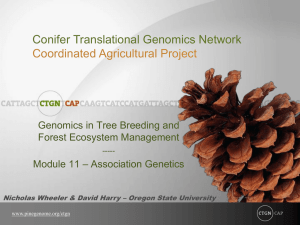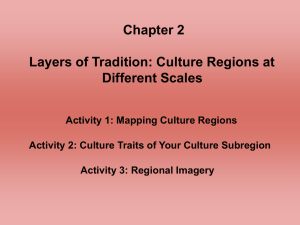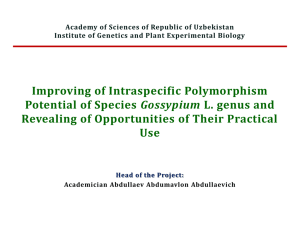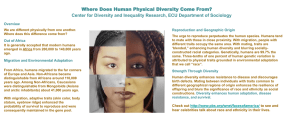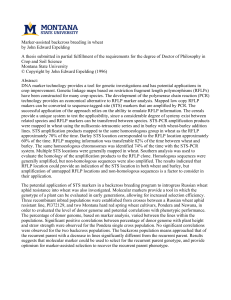Improvement of Rainfed Lowland Rice Variety for Cooking Quality
advertisement
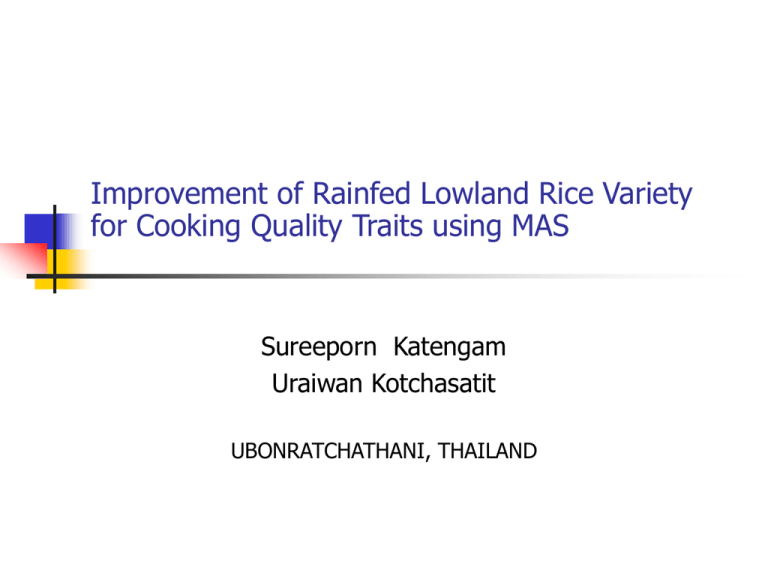
Improvement of Rainfed Lowland Rice Variety for Cooking Quality Traits using MAS Sureeporn Katengam Uraiwan Kotchasatit UBONRATCHATHANI, THAILAND Background Rice production in NE of Thailand Area of production ranging from drought-prone lands to flooding area Abiotic stresses related with unpredictable rainfall pattern are main problems State of problem Abiotic stresses associated with unpredictable rainfall pattern are main problems for rice production in NE of Thailand. Elite cultivars resistance to drought are required. State of problem (cont.) KDML105, an aromatic rice with good cooking quality, is widely grown in NE, however, its production is dominating constraint with the drought problem. Drought tolerance is a complex traits since this trait is governed by many QTLs locating in many chromosome (ch1, ch2, ch3, ch4, ch7, ch8,and ch9). Therefore, improvement KDML105 for drought resistance is not an easy tasks. State of problem (cont.) In the opposite way, improving of well adapted variety to drought prone areas for other quality traits such as cooking quality is worth to reconsider. Cooking quality trait is determined by three characters specifying the physical properties of starch in the endosperm: Amylose content (AC) Gel consistency (GC) Gelatinization temperature (GT) Objectives Marker-assisted backcross breeding is aimed at improving well drought adapted variety to rainfed lowland area of NE of Thailand for cooking quality traits utilizing tightly linked DNA markers. The major QTL controlling AC, GC, and GT are located on Ch.6. DNA marker of flanking markers closely linked to this major QTL controlling quality traits will be carried out for MAS. Plant materials Donor parent: KDML105 low AC (~16-17%): major QTL on ch6 (at Wx gene ) low GT: major QTL on ch6 medium GC: major QTL on ch6 (at Wx gene ) Recipient parent: IR57514-drought Breeding scheme: Genetic map (Azu / IR64 ) Chr.6 Chr.11 Map location of QTLs controlling cooking quality traits Survey of SSR markers for parent screening Expected size (bp) # Markers Traits Chrom KDML 105 IR57514 KD571-77Size expected Remark 1 BADH Aroma 8 ~ 400 ~410 ~400 Polymorphic 2 RM190 Amylose content 6 ~120 ~116 ~120 3 Waxy & Gel consistency 6 ~311 ~315 ~311 4 RM204 6 ~155 ~119 ~155 5 RM205 6 121 121 121 6 7 RM225 RM111 Gelatinization 6 6 ~145 120 ~120 120 ~145 120 140 124 Polymorphic Monomorphic 8 RM50 temperature 6 200 200 200 201 Monomorphic 9 RM121 6 ~275 ~272 ~275 Polymorphic 10 PSS-1-1 6 149 149 149 Monomorphic 11 PSS2-2 6 200 no 200 12 RM136 6 290 290 290 13 GT11 6 ~200 ~195 ~200 14 RM229 11 ~119 ~119 200 116 ? 15 RM457 11 ~230 ~232 ~230 230 Polymorphic 16 RM21 11 no no no 157 ? 17 RM473E 11 141, 139 122,119,118 118 Multiple bands 117 117,116 (repeat) 124 Polymorphic Polymorphic 169 Polymorphic Monomorphic 101 Monomorphic Polymorphic 18 RM206 11 ~160 ~148 ~120 147 ? (repeat) 19 RM254 11 ~156 ~156 ~153 165 ? 20 21 PB7-8 RBO 783 Bacterial leaf blight(Xa21) 11 no 375 no ~350 no ~350 Submergence tolerance 9 ? (repeat) Monomorphic 553bp 500bp RM121 RM21 WAXY BADH PSS II-1 PSS II-2 RM473E RM206 RM254 RM21 RM229 RM457 RM50 RM121 RM136 GT11 PCR condition 1 2 3 726bp RM597 RM190 RM204 RM205 RM225 RM111 Screening parents with SSR markers 427bp 311bp 249bp 200bp Thermal cycling 151bp 140bp 118bp 100bp 1 KD 2 IR57514 3 KD571-77 SSR markers chosen for parents screening # Markers Traits 1 BADH Aroma 8 ~410 ~400 2 RM190 Amylose content 6 ~116 ~120 3 Waxy & Gel consistency 6 ~312 ~311 4 RM204 6 ~119 ~155 5 GT11 Gelatinization 6 ~195 ~200 6 PSS2-2 temperature 11 7 RM457 11 8 RM21 11 157 repeat 9 RM206 11 147 repeat 10 PB7-8 Bacterial leaf blight(Xa21) 11 Chrom IR57177 KD571-77Expected size (bp) Remark 124 169 Agarose ~232 ~230 230 Agarose 2nd workshop on December MAS for BC1F1 Planting parents donor KD571-77 X early-April recipient late-June IR57514 F1 mid-July Planting F1 and recipient parents Line selection with selected SSR markers early-August F1 X IR57514 mid-October BC1F1 mid-November MAS 1 2 3 4………………………………. .200 lines late -November


